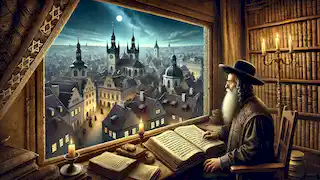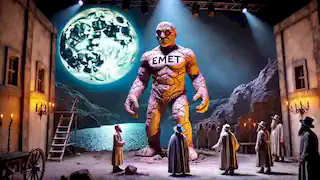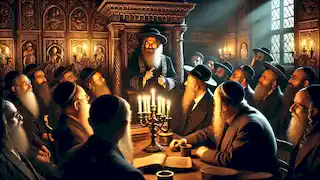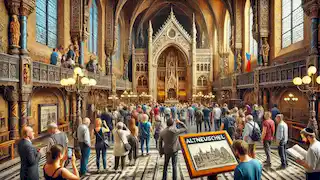The Golem of Prague
Reading time: 10 min

About this story: The Golem of Prague is a Legend from Czech Republic set in the Renaissance This Dramatic tale explores themes of Courage and is suitable for All Ages. It offers Cultural insights.
The Threat
In the heart of Prague, nestled among cobblestone streets and ancient spires, there was a community perpetually under threat. It was the late 16th century, and the Jewish Quarter faced increasing hostility from those who misunderstood and feared them. Rabbi Judah Loew ben Bezalel, known as the Maharal of Prague, was a revered scholar and mystic, deeply concerned for his people. Each night, he would pace in his study, contemplating the plight of his community.
One evening, as he poured over sacred texts in search of guidance, a mystical passage caught his eye. It spoke of the Sefer Yetzirah, a book of creation, and the power to breathe life into inanimate clay. The rabbi's mind raced with possibilities. Could he create a protector for his people? With a heart full of both hope and trepidation, he decided to undertake the ancient and perilous ritual.
In the dead of night, Rabbi Loew, accompanied by his most trusted disciples, slipped out to the banks of the Vltava River. By the pale moonlight, they shaped a massive figure from the river's clay. The golem took form, a giant of a man with a face devoid of expression. Rabbi Loew chanted incantations, and with each word, the clay seemed to pulse with a life of its own. Finally, he inscribed the Hebrew word "Emet," meaning truth, upon the golem's forehead.
"Arise, Josef," the rabbi commanded. The golem's eyes opened, and he stood, towering over the men who had given him form.

Josef was brought to the synagogue and hidden in the attic. By day, he was an unremarkable statue, but by night, he patrolled the streets of the Jewish Quarter, a silent sentinel. The anti-Semitic attacks dwindled, as the perpetrators found themselves facing an unstoppable force. The community, sensing the divine protection, breathed a collective sigh of relief.
The Dilemma
As months turned into years, the golem Josef became a beloved figure in the Jewish Quarter. He helped with heavy labor, protected the vulnerable, and maintained a constant vigil. Rabbi Loew, however, was troubled. He knew that the golem, though a guardian, was also a potential danger. Josef lacked a human soul and understanding; he followed orders without question, without mercy.
One fateful day, an incident occurred that shook the community. A child, curious and playful, had wandered into Josef's path. The golem, programmed to protect and react to any perceived threat, nearly crushed the child before being stopped by a quick-thinking passerby. The rabbi realized that Josef's power, unchecked, could bring as much harm as good.
With a heavy heart, Rabbi Loew began to consider how to deactivate the golem. He spent nights in prayer and meditation, seeking divine guidance. The answer came to him in a dream, as many of his insights did. He would have to erase the word "Emet" from Josef's forehead, rendering him lifeless once more.
Before taking this drastic step, Rabbi Loew decided to hold a council with the elders of the community. They gathered in the synagogue, the air thick with the weight of their discussion. Opinions were divided; some feared the loss of their protector, while others worried about the growing unpredictability of the golem.
"We must trust in God," Rabbi Loew said finally. "The golem has served his purpose, but we cannot allow ourselves to become dependent on a creation that we cannot fully control."
The Farewell
The night was solemn as Rabbi Loew and his disciples made their way to the attic of the synagogue. Josef stood there, motionless and uncomprehending. The rabbi approached, his hand trembling as he prepared to erase the sacred word from the golem's forehead.
"Thank you, Josef," he whispered. "You have been a faithful guardian."
With a single stroke, the letter 'E' was erased, leaving the word "Met" - death. Josef's eyes dimmed, and he collapsed into a heap of clay. The men stood in silence, mourning the loss of their protector and contemplating the fragile balance between creation and destruction.

The following day, the news spread throughout the Jewish Quarter. There was a mixture of sorrow and relief. Life resumed its rhythm, and the community continued to thrive, bolstered by the unity and strength that had been fortified during Josef's guardianship.
Years passed, and the legend of the golem became a cherished story passed down through generations. Rabbi Loew's wisdom and the golem's silent vigil were remembered as a testament to the resilience and faith of the people.
The Legacy
The golem's story didn't end with his deactivation. The clay that once formed Josef was carefully preserved in the synagogue's attic, a reminder of the power and responsibility that comes with creation. Rabbi Loew continued to teach and guide his community, his experiences with the golem deepening his understanding of divine mysteries.
In the years that followed, Prague's Jewish Quarter faced many challenges, but the memory of Josef provided a source of inspiration. The community rallied together in times of hardship, drawing strength from their shared history. The golem had shown them that they were not powerless, that they could protect themselves and their loved ones through unity and courage.
Rabbi Loew lived to a venerable age, his wisdom and teachings leaving a lasting impact on his community. Upon his passing, he was buried with great honor, and his grave became a place of pilgrimage. People came from far and wide to pay their respects and seek guidance at the resting place of the man who had dared to bring clay to life.
The attic of the synagogue, where Josef had once stood, became a place of reverence. Children would visit, wide-eyed and full of wonder, as elders recounted the tale of the golem. The clay remained untouched, a sacred relic of a time when a community had been saved by the courage of its rabbi and the strength of its creation.
The Modern Era
In the modern era, the legend of the golem continued to captivate imaginations. Scholars and historians studied Rabbi Loew's writings, fascinated by the blend of mysticism and pragmatism. The story of Josef the golem was retold in countless books, plays, and films, each interpretation adding new layers to the ancient tale.
Prague itself became a vibrant city, its rich history attracting visitors from around the world. The Jewish Quarter, with its synagogues and museums, stood as a testament to the enduring spirit of its people. Tourists would often visit the Altneuschul, the Old-New Synagogue, hoping to catch a glimpse of the attic where Josef had once stood.

In this way, the golem of Prague transcended its origins, becoming a symbol of hope and resilience. The story reminded people of the power of faith, the importance of wisdom, and the enduring strength of community. It was a legacy that lived on, inspiring generations to face their own challenges with courage and unity.
Hidden Chapters
Despite the widespread fascination with the golem, many aspects of Rabbi Loew's life and his creation remained shrouded in mystery. Old manuscripts hinted at other mystical works performed by the rabbi, each imbued with a deep sense of purpose and reverence. Scholars and theologians often debated the true extent of his powers and the secrets he took to his grave.
One such mystery involved the exact location of Rabbi Loew's hidden writings. It was said that somewhere within the Jewish Quarter lay a concealed chamber containing manuscripts that detailed his deepest spiritual insights and rituals, including the full instructions for creating a golem. This legend spurred countless treasure hunts and scholarly expeditions, yet the chamber remained undiscovered, its contents a tantalizing enigma.
Echoes of the Past
In the late 20th century, a young historian named Miriam dedicated her life to uncovering the lost secrets of Rabbi Loew. Miriam was born and raised in Prague, her fascination with the city's Jewish history sparked by tales her grandmother told her as a child. She had spent years poring over ancient texts and interviewing elders, piecing together fragments of the past.
One autumn evening, while exploring the labyrinthine passages of the Jewish Quarter, Miriam stumbled upon a hidden door in the cellar of an old synagogue. Her heart raced as she carefully opened it, revealing a narrow staircase leading down into darkness. With a lantern in hand, she descended into what appeared to be a forgotten library. Dusty shelves lined the walls, filled with scrolls and books that hadn't been touched in centuries.
Among the cobwebs and shadows, Miriam found a large, ornate chest. Her hands trembled as she opened it, revealing stacks of parchment covered in Rabbi Loew's meticulous handwriting. Her breath caught as she realized she had found the fabled hidden chamber. The manuscripts detailed not only the creation of the golem but also numerous other mystical rituals and theological discourses.

Miriam's discovery reignited global interest in Rabbi Loew's life and work. Scholars from around the world flocked to Prague to study the manuscripts, and the Jewish Quarter became a bustling hub of intellectual activity. The newfound knowledge further enriched the community's heritage, shedding light on the rabbi's profound wisdom and enduring legacy.
Reflections
As the story of the golem continued to evolve, it served as a reflection of the human condition. The themes of creation, protection, and the ethical implications of power resonated deeply with people from all walks of life. Artists and writers found endless inspiration in the tale, each adding their unique perspective to the narrative tapestry
.
One such artist, a sculptor named David, was particularly moved by the legend. He spent years crafting a series of statues that depicted key moments from the golem's story. His works were displayed in a special exhibition at the Jewish Museum in Prague, drawing thousands of visitors. Each statue captured the essence of the narrative, from the rabbi's moment of inspiration to the golem's deactivation.
The exhibition also included interactive elements, allowing visitors to engage with the story on a personal level. Virtual reality experiences transported them to 16th century Prague, where they could witness the creation of the golem and walk through the streets of the Jewish Quarter. These innovations breathed new life into the ancient legend, making it accessible and relevant to a modern audience.
A Symbol of Hope
The golem of Prague had become more than just a story; it was a symbol of hope and resilience. In times of crisis, people would look to the legend for inspiration, finding strength in the rabbi's courage and the golem's unwavering protection. The narrative transcended cultural and religious boundaries, resonating with anyone who had ever faced adversity.
In the wake of global challenges, such as the rise of anti-Semitism and the threat of cultural erasure, the story of the golem served as a powerful reminder of the importance of unity and vigilance. Communities around the world drew parallels between their struggles and those faced by Prague's Jewish Quarter, using the legend as a rallying cry for solidarity and resistance.
The Future
As the 21st century progressed, the legend of the golem continued to evolve. Advances in technology and communication allowed the story to reach new audiences, and its themes of creation and protection became more relevant than ever. Scholars and scientists explored the ethical implications of artificial intelligence and robotics, often drawing comparisons to the golem.
The Jewish Quarter of Prague remained a vibrant and thriving community, its rich history serving as a foundation for future generations. The Altneuschul, now a UNESCO World Heritage site, continued to attract visitors from around the world. Guided tours and educational programs ensured that the legend of the golem was passed down, preserving its legacy for years to come.
In the end, the golem of Prague stood as a testament to the enduring power of faith, wisdom, and community. Its story, deeply rooted in the past, continued to inspire and guide those who looked to the future with hope and determination. The legacy of Rabbi Loew and his creation remained a beacon of light, illuminating the path for generations to come.
















